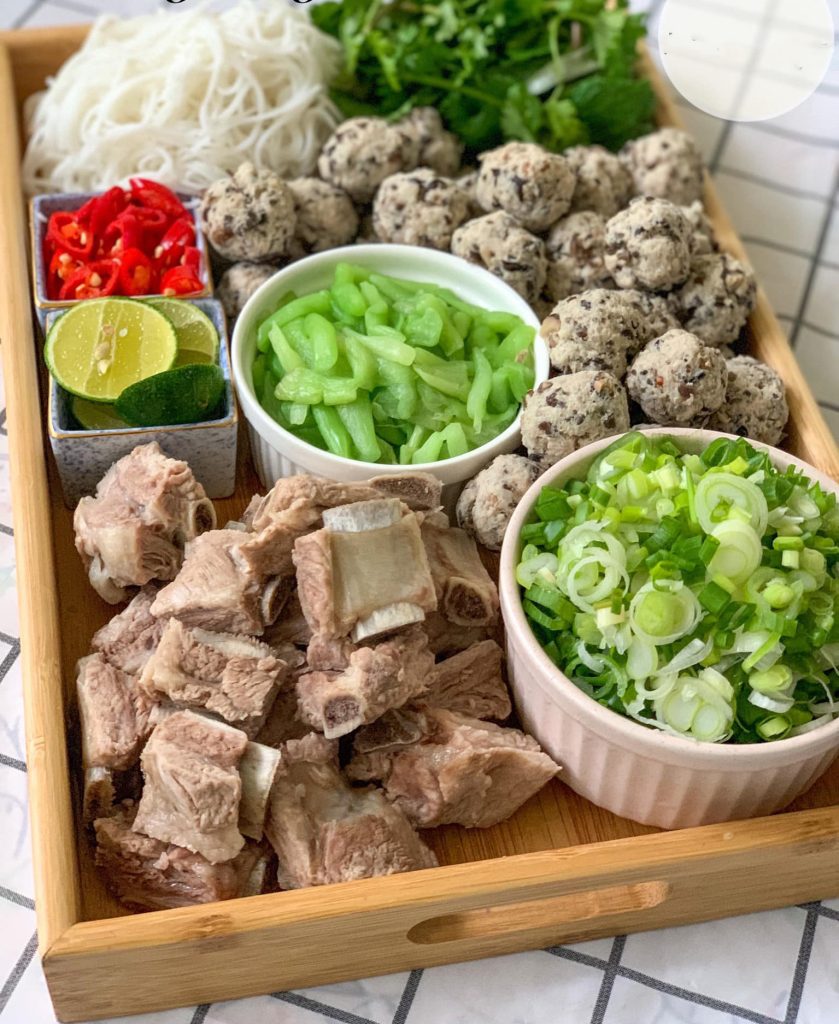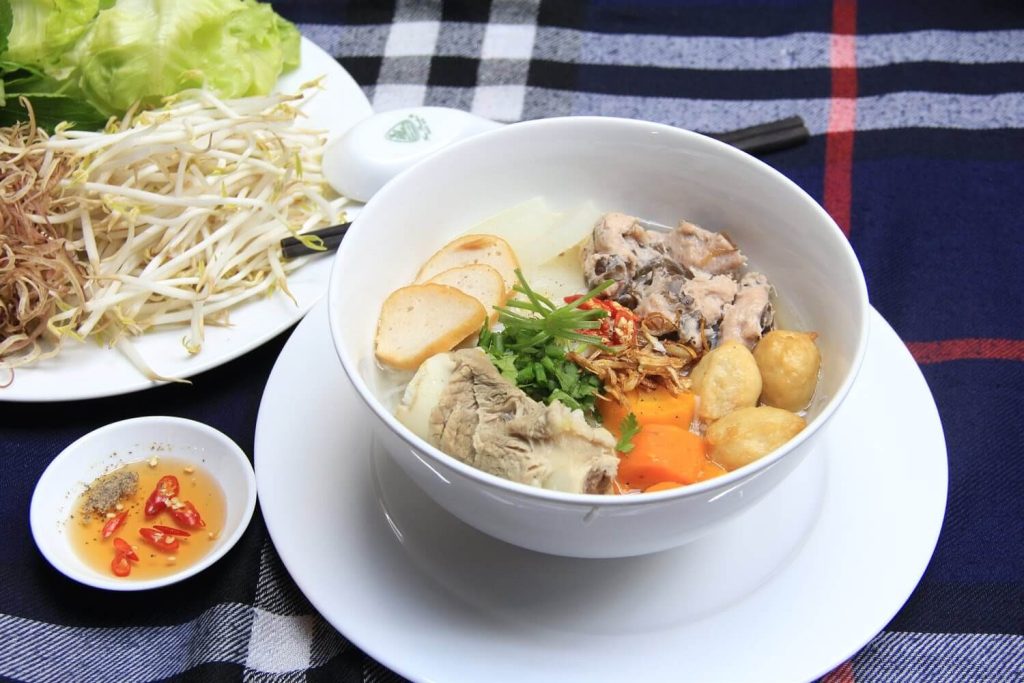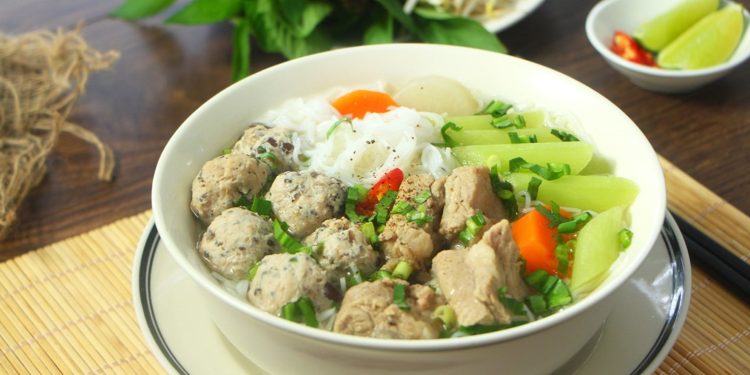Bun Moc Doc Mung, a traditional Vietnamese dish, is a delightful noodle soup that embodies the essence of the country’s rich culinary heritage. Its name is derived from its key ingredients: “mọc” (pork meatballs) and “dọc mùng” (taro stems), served in a light yet flavorful broth with vermicelli noodles. Originating from the northern region of Vietnam, this dish carries cultural significance, symbolizing simplicity and home-cooked comfort. When one mentions Bun Moc Doc Mung, it evokes an image of steaming bowls, vibrant with fresh herbs and the inviting aroma of pork and spices.
History
The roots of Bun Moc Doc Mung can be traced back to rural villages in northern Vietnam, where locally sourced ingredients were transformed into hearty meals. In the early days, this dish was a staple in peasant households, made from easily accessible ingredients like pork, taro stems, and fresh rice noodles. Over time, it became a beloved dish served at family gatherings and local markets.
The simplicity of Bun Moc Doc Mung reflects the resourcefulness of Vietnamese people, who crafted meals that were both nourishing and flavorful despite limited resources. Today, it is a dish that bridges generations, reminding older generations of their childhood and introducing younger ones to the flavors of their heritage. It’s not uncommon to find families sharing fond memories around a steaming pot of Bun Moc Doc Mung during festive occasions or quiet weekends.

Recipe
Creating Bun Moc Doc Mung is a rewarding culinary experience that celebrates traditional cooking techniques. Here’s a detailed guide:
Ingredients:
- For the broth:
- 1.5 kg of pork bones (preferably femur or rib bones)
- 1 large onion (peeled and halved)
- 1 piece of ginger (sliced and charred)
- 2 liters of water
- 1 tablespoon fish sauce
- 1 teaspoon salt
- 1 teaspoon rock sugar
- For the meatballs (mọc):
- 500 g ground pork
- 100 g pork paste (giò sống)
- 1 tablespoon minced shallots
- 1 tablespoon fish sauce
- ½ teaspoon ground pepper
- For the soup:
- 300 g taro stems (dọc mùng), peeled and cut into bite-sized pieces
- 500 g fresh vermicelli noodles (bún)
- Fresh herbs: cilantro, scallions, and Vietnamese coriander (rau răm)
- Lime wedges and chili slices (optional)
Instructions:
- Prepare the broth:
- Blanch the pork bones in boiling water for 5 minutes to remove impurities. Rinse thoroughly.
- In a large pot, add the bones, onion, ginger, and water. Bring to a boil, then lower the heat and simmer for 1.5-2 hours, skimming off any foam for a clear broth.
- Season the broth with fish sauce, salt, and rock sugar. Adjust the flavor to taste.
- Make the meatballs:
- In a bowl, combine ground pork, pork paste, minced shallots, fish sauce, and ground pepper. Mix thoroughly until the mixture becomes slightly sticky.
- Shape the mixture into small, bite-sized meatballs and set aside.
- Cook the taro stems:
- Prepare the taro stems by peeling off the fibrous outer layer. Cut into 5 cm pieces and soak them in salted water for 15 minutes to reduce their itchiness.
- Blanch the taro stems in boiling water for 2 minutes, then rinse and drain.
- Assemble the soup:
- Bring the broth to a gentle boil and add the meatballs. Cook until they float to the surface, indicating they are fully cooked.
- Add the blanched taro stems to the broth and simmer for another 5 minutes.
- Cook the vermicelli noodles according to the package instructions and divide them into serving bowls.
- Serve:
- Ladle the hot broth, meatballs, and taro stems over the noodles. Garnish with fresh herbs and serve with lime wedges and chili slices for an extra kick.
Cooking Bun Moc Doc Mung is an immersive experience, offering a sense of connection to Vietnamese traditions and the joy of crafting something meaningful from simple ingredients.

Tips for the Perfect Bun Moc Doc Mung
- Clear broth: Skim impurities frequently during the simmering process to ensure a clean and light broth.
- Flavor balance: Adjust the seasoning gradually, tasting as you go to achieve the perfect balance of sweetness and saltiness.
- Fresh taro stems: Choose young, tender taro stems to avoid a fibrous texture. Soaking them in salted water helps reduce itchiness when eaten.
- Homemade pork paste: If time permits, making pork paste from scratch adds an extra layer of authenticity to the dish.
The sense of accomplishment when you finally finish cooking Bun Moc Doc Mung is deeply satisfying, as the aroma fills your kitchen, inviting everyone to gather around for a hearty meal.
Cultural Significance
Bun Moc Doc Mung holds a special place in Vietnamese culture, often associated with family gatherings and community bonds. It is a dish that brings people together, whether shared during Tet (Lunar New Year) or enjoyed as a comforting meal on a rainy day. The use of taro stems reflects the connection to rural life, where seasonal ingredients are celebrated for their freshness and versatility.
This dish also highlights the creativity and adaptability of Vietnamese cuisine, showcasing how humble ingredients can be elevated into something truly memorable. For many, a bowl of Bun Moc Doc Mung is a reminder of home and the warmth of shared meals with loved ones.
Emotions and Experiences
The first taste of Bun Moc Doc Mung is an unforgettable experience. The light yet flavorful broth soothes the palate, while the tender meatballs and the slightly crunchy taro stems create a delightful contrast of textures. The addition of fresh herbs and a squeeze of lime enhances the dish’s complexity, leaving a lasting impression.
For those who grew up with this dish, Bun Moc Doc Mung carries a deep sense of nostalgia. It evokes memories of mothers and grandmothers skillfully preparing the broth, the laughter of family members gathered around the table, and the comforting warmth of home-cooked food. Each bowl tells a story, connecting individuals to their roots and to one another.
Conclusion
Bun Moc Doc Mung is more than just a dish; it is a celebration of Vietnamese culture, history, and culinary artistry. Its simple ingredients and profound flavors make it a must-try for anyone seeking an authentic taste of Vietnam. By savoring Bun Moc Doc Mung, you not only enjoy a delicious meal but also embrace the stories and traditions that make it so special. So, why not embark on this culinary journey and experience the heartwarming magic of Bun Moc Doc Mung for yourself?








Discussion about this post